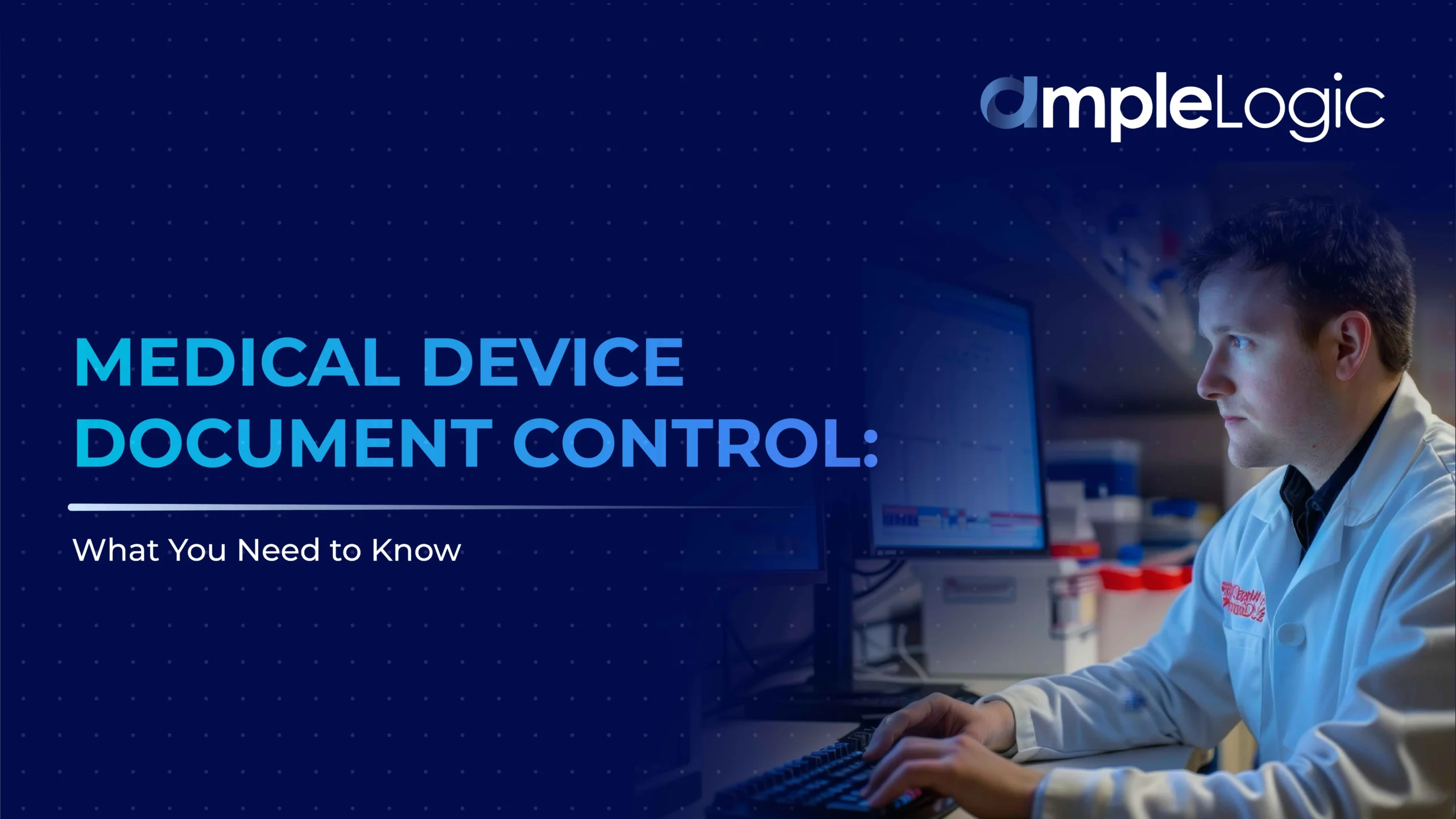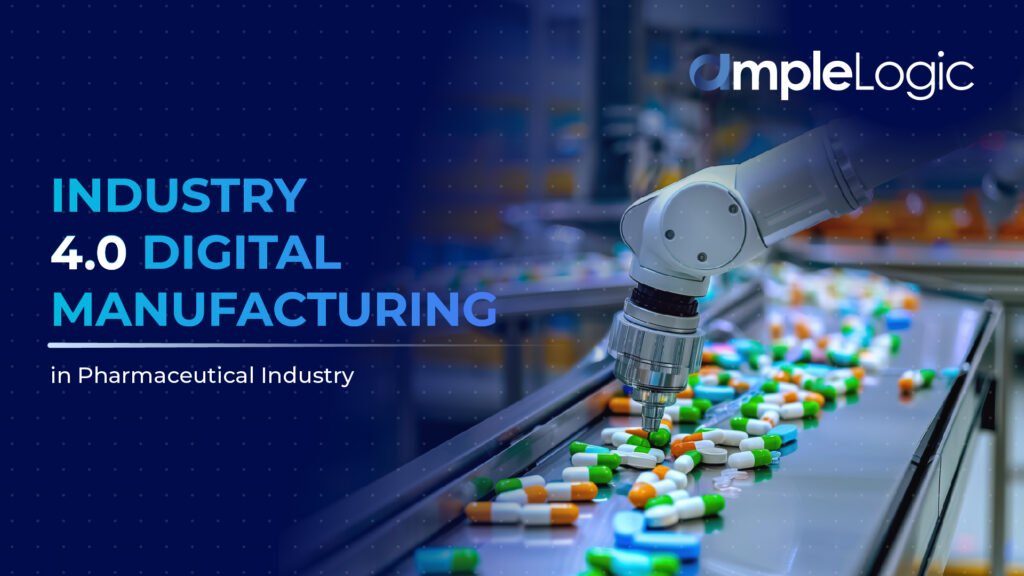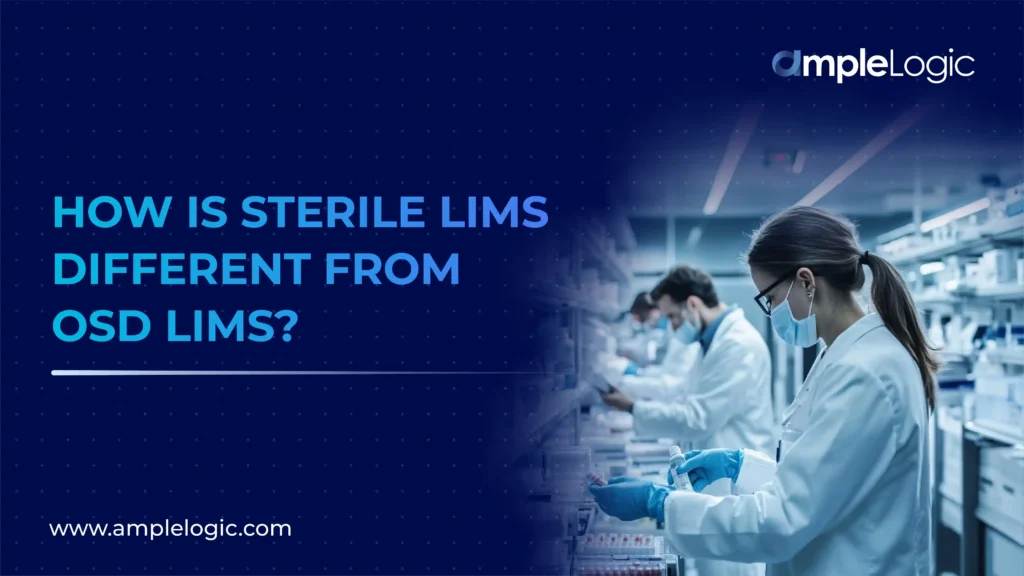
Document control is a fundamental requirement for regulatory compliance, quality control, and operational effectiveness in the highly regulated field in which device developers operate. Medical device regulatory bodies also expect organizations to put systematic control over medical device documents during the lifespan of that document, covering medical device quality management system standards or regulations like ISO 13485:2016, EU MDR, FDA 21 CFR Part 820, and FDA 21 CFR Part 11. Thus, here come the questions about medical device document controls.
In order to streamline these medical device document controls, lower compliance risks, and enhance operational transparency in the face of growing regulatory scrutiny, medical device establishments need to implement a strong Document Management System (DMS). AmpleLogic’s AI-powered DMS offers a complete system that automates document management, guaranteeing operational effectiveness and regulatory compliance.
What Is Medical Device Document Control?
Medical device document control is the systematic process for organizing essential documents and records related to the design, development, manufacturing, and compliance of Medical Devices. It is this structuring by which documents are created, approved, tracked, and archived to ensure data integrity and accessibility.
Objectives of Medical Device Document Control
- Regulatory Compliance – Ensures compliance with global regulatory frameworks like ISO 13485, EU MDR, and FDA regulations.
- Document Integrity – Guarantees version control, audit trails, and access only to authorized personnel.
- Traceability – Document retrieval is easier during audits and inspections as it offers a structured system.
- Operational Efficiency – Reduces the administrative burden using automation and workflow optimization
To reconcile these processes, AmpleLogic’s Document Management System (DMS) helps manage documents in a simple way using automated workflows and regulatory compliance.
Role of a Document Management System (DMS) in Medical Device Document Control
In medical device document control, compliance, and process standardization can be best managed through the use of a Document Management System (DMS). With AmpleLogic’s AI DMS, medical device manufacturers get a secure, centralized, and cloud-based platform, empowered by Artificial Intelligence to manage, store, and track documents, with rigid analytics for better outcomes. But can you differentiate between Document Control and Document Management?

| Feature | Document Control | Document Management |
|---|---|---|
| Primary Purpose | Regulatory compliance, version control, and security | Organizing, storing, and managing document workflows |
| Scope | Focuses on tracking, approving, and securing critical documents | Encompasses document control plus broader storage and collaboration tools |
| Regulatory Compliance | Ensures adherence to ISO, FDA, EU MDR, and GMP requirements | Supports compliance by organizing regulatory documents but lacks strict control mechanisms |
| Version Control | Tracks changes, maintains audit logs, and prevents unauthorized edits | Allows document revisions |
| Access Control | Restricts document edits to authorized personnel | Enables role-based access but may allow broader user modifications |
| Retention & Archiving | Ensures documents are retained for required regulatory periods | Stores documents efficiently |
| Collaboration | Limited to regulatory users with controlled approvals | Enables broader team collaboration, including external stakeholders |
| Integration with Other Systems | Primarily integrated with QMS and regulatory compliance software | Connects with enterprise-wide systems (ERP, CRM, and HR software) |
Steps in the Medical Device Document Control Process
Medical device document control software follows a structured process to ensure regulatory compliance and document integrity.
7 Steps in Document Control
- Document Identification – Assigns unique IDs to each document for easy tracking and version control.
- Document Review – Ensures accuracy and compliance through expert evaluations.
- Document Approval – Requires formal approval from designated personnel before implementation.
- Document Tracking – Monitors document versions and access history to maintain regulatory compliance.
- Change Control – Implements structured change processes with appropriate reviews and approvals.
- Record Retention and Archiving – Ensures secure storage of documents for audit and regulatory purposes.
- Document Retirement – Deactivates outdated documents to prevent unauthorized usage.
Types of Documents in Medical Device Document Control

Medical device companies manage various documents to ensure compliance, maintain quality, and support manufacturing processes.
Common Document Types
- Quality Manual – Defines Quality Management System (QMS) policies and objectives.
- Design History File (DHF) – Documents the complete design and development process.
- Standard Operating Procedures (SOPs) – Outlines standard processes to ensure uniformity and compliance.
- Work Instructions (WIs) – Provides step-by-step directives for specific tasks.
- Technical Files – Contains safety and performance data required for regulatory submissions.
- Risk Management Plans – Identifies and mitigates potential risks associated with the device.
- Post-Market Surveillance (PMS) Plan – Outlines processes for monitoring device performance post-market release.
Types of Records in the Medical Device Industry

Medical device companies are required to keep multiple records to comply with various regulations, maintain quality, and trace their product. Some key record types required under ISO 13485, FDA 21 CFR Part 820, and EU MDR are given below:
- Device Master Record (DMR)
- Device History Record (DHR)
- Post-Market Surveillance (PMS) Records
- Corrective and Preventive Action (CAPA) Records
- Audit Reports
- Training Records
- Environmental Monitoring Records
Such compliance ensures risk mitigation and quick audit processes. AmpleLogic DMS provides a structured approach to managing these documents digitally, ensuring accessibility, security, and compliance.
Regulatory Standards Governing Medical Device Document Control
Medical device document control must comply with standards on a global scale to ensure the safety, effectiveness, and regulatory approval of medical devices. The smart technology, like AmpleLogic DMS, can keep you compliant with such regulatory frameworks through automated documentation management and secure storage solutions.
Regulatory Requirements for Medical Device Documentation: Here are the regulatory requirements for medical device documentation across different standards and regulations
| Regulation/Standard | Purpose | Key Document Control Requirements |
|---|---|---|
| ISO 13485:2016 | Defines a quality management system (QMS) for medical device manufacturers. | - Section 4.2.4: Requires procedures for document approval, review, update, and distribution to prevent obsolete documents from being used. |
| - Section 4.2.5: Mandates procedures for record identification, storage, security, retrieval, retention, and disposal. - Ensures legibility, traceability, and controlled access to documents. | ||
| Regulation (EU) 2017/745 (EU MDR) | Establishes documentation standards for medical devices marketed in the European Union | - Annex II: Specifies content requirements for technical documentation. |
| - Annex III: Defines documentation requirements for post-market surveillance. | ||
| - Article 10: Requires manufacturers to maintain QMS documentation and retain technical files for at least 10 years (15 years for implantable devices) | ||
| - Articles 83 & 84: Mandate documentation for post-market surveillance and safety monitoring. | ||
| - Annex IX: Requires document control for conformity assessments conducted by notified bodies. | ||
| FDA 21 CFR Part 820 (Quality System Regulation - QSR) | Establishes documentation requirements for medical devices in the U.S. | Section 820.40 (Document Controls): Requires document approval, distribution, and modification procedures. - Mandates version control, authorized approvals, and traceability of changes. - Ensures that only current, approved documents are used at relevant locations. - Requires record retention for traceability and regulatory inspections. |
| FDA 21 CFR Part 11 (Electronic Records & Signatures) | Defines the criteria for electronic records and digital signatures to ensure data integrity. | - 21 CFR 11.10(k): Requires organizations to prevent unauthorized access to electronic records. |
| - Section 11.30: Specifies additional controls for open systems to protect data integrity. | ||
| - Section 11.50: Mandates electronic signatures to include the signer's name, date, time, and purpose of the signature | ||
| - Section 11.70: Requires linking electronic signatures to their associated records to prevent tampering. | ||
| - Section 11.100: Establishes unique user identifiers and secure password management. | ||
| - Section 11.20 & 11.30: Define security controls for electronic signatures, user authentication, and password protection |
Why Choose AmpleLogic DMS for Medical Device Document Control?
AmpleLogic AI DMS is an advanced, AI-enabled Document Management System (DMS) to manage document control, regulatory compliance, and data security in the medical device field. Our end-to-end digital solution streamlines the way documents are created, shared, approved, stored, managed, and archived to minimize compliance risks and increase operational efficiencies.
7 Features of AmpleLogic’s AI-Powered DMS
1. Document Lifecycle Management
- Automates document creation, approval, version control, and archival to ensure compliance with FDA 21 CFR Part 820, ISO 13485, and EU MDR.
- Manages SOPs, Batch Manufacturing Records (BMRs), Device Master Records (DMRs), risk management files, and training records throughout their lifecycle.
2. AI-Powered OCR
- Converts scanned documents and handwritten notes into searchable and editable text for improved accessibility.
3. Voice-Activated Search
- Allows instant document retrieval using voice commands.
- Understands medical device terminology for precise search results, enhancing efficiency.
4. Smart Version Control
- Allows instant document retrieval using voice commands.
- Understands medical device terminology for precise search results, enhancing efficiency.
5. Regulatory Compliance
- Complies with global regulatory standards such as FDA, ISO, EU MDR, MHRA
6. Secure Digital Storage with Backup & Recovery
- Implements role-based access, encryption, and AI-driven anomaly detection to prevent data breaches.
- Automates disaster recovery and regulatory archiving, ensuring documents are secure and audit-ready.
7. Intelligent Document Issuance & Print Control
- Tracks issuance of controlled, uncontrolled, master, and reference copies for audit traceability.
- Implements automated print request approvals and tracking to prevent unauthorized duplication.
Conclusion
In summary, effective medical device document control software leads to better regulatory compliance, improved product quality, and more efficient operations. With stringent documentation requirements to comply with ISO, FDA, or EU MDR, manufacturers need to embrace an advanced Document Management System (DMS) that facilitates efficient handling of documents.
AmpleLogic DMS offers a comprehensive digital solution to streamline fda compliance document control and ensure compliance. Explore AmpleLogic today to see how it can transform your medical device document control process. Also, you can visit our page for other such informative articles – AmpleLogic Resources!





























